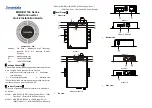
Operation | 23
1/3 Rack Block Downconverters (Option 17)
DNB1-XTR, Rev.N, 8/14/2012
®
SYSTEM FAULT STATUS = ALR
The SET command requires nine parameters. All but the
fi
rst parameter are ignored. The
fi
rst parameter is used to set or
clear a user generated test fault.
Command
Command
Parameters
Parameters
Remote Command Sequence: $ALRabcdefghi
Unit Response:
$ALR
The QUERY command requires no parameters.
Command
Command
Parameters
Parameters
Remote Command Sequence: ?ALR
Unit Response:
?ALRabcdefghi
?ALR: Component Fault Status indicator
a-i: “0” or “1” ASCII numeric character
0 = No fault
1 = Fault
a-i indicates the status of the component faults described below.
a Test Alarm
b Logged Alarm
c LO Alarm
d Power Supply Alarm
e LO Level Fault (Optional)
f Accessory Fault (Optional) (Fiber, LNA) See ?AAL
for de
fi
nition of fault
g External Fault
h Temperature Alarm
i Module Communications Alarm
UNIT ATTENUATION = ATT or AT1
The SET command requires a three-digit parameter representing the attenuation in dB. The three-character string “INC”
or “DEC” can be used in place of the attenuation parameter to increment or decrement the attenuator by 0.2 dB. This
event is logged in the unit event log.
For uplink power control installations, or installations where attenuation is constantly updated, this command should
NOT
be used. Use ATN, AN1, AN2 for continuous adjustment situations.
Command
Command
Parameters
Parameters
Remote Command Sequence: $ATTttt, $ATTINC or $ATTDEC
Unit Response:
$ATT
The QUERY command requires no parameters.
Command
Command
Parameters
Parameters
Remote Command Sequence: ?ATT
Unit Response:
?ATTttt
ATT: Attenuation indicator
ttt: Three-digit parameter indicating attenuation in tenths of a dB.
INC: Used in place of “ttt” to increment the attenuator 0.2 dB
DEC: Used in place of “ttt” to decrement the attenuator 0.2 dB















































